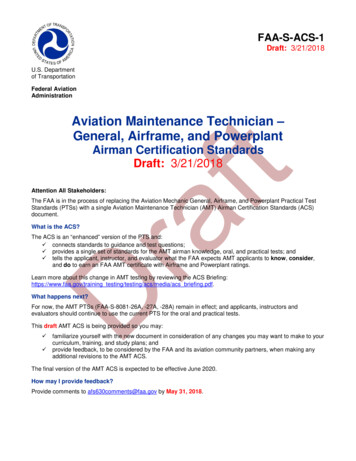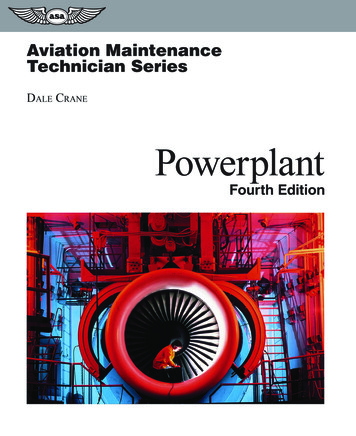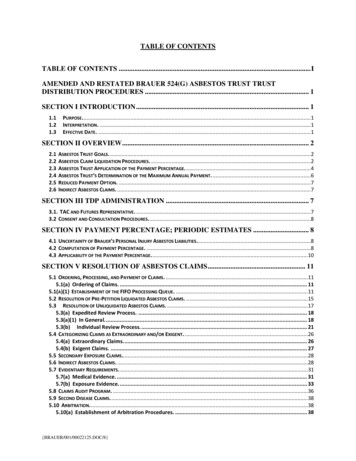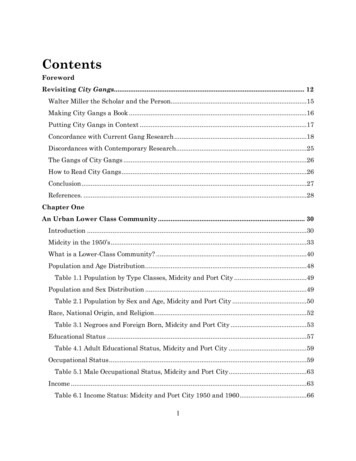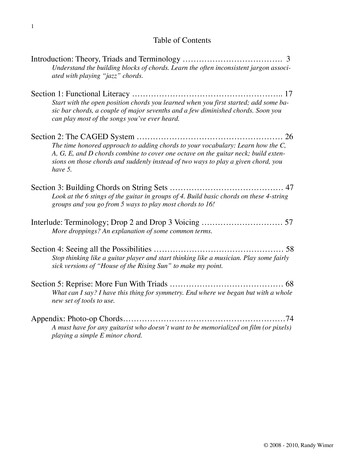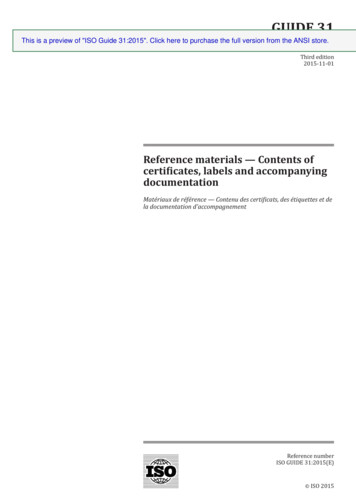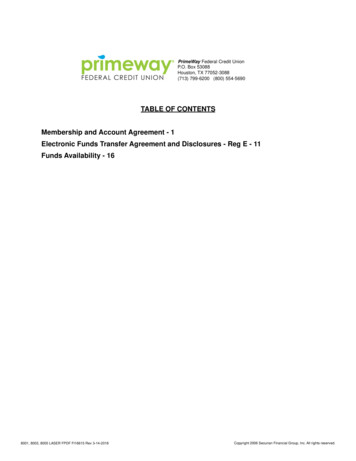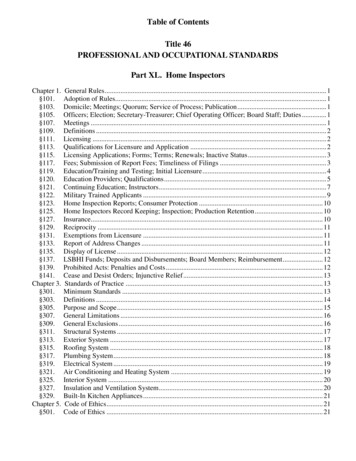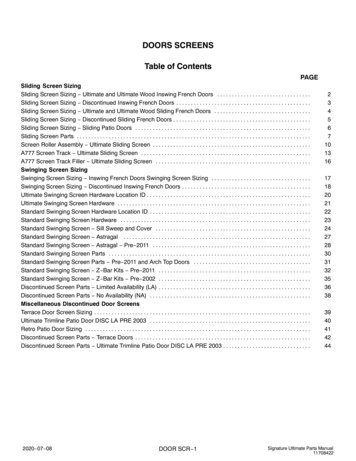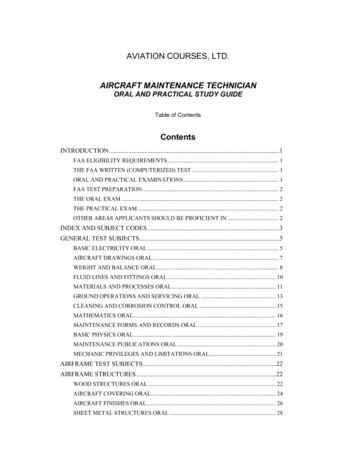
Transcription
AVIATION COURSES, LTD.AIRCRAFT MAINTENANCE TECHNICIANORAL AND PRACTICAL STUDY GUIDETable of ContentsContentsINTRODUCTION .1FAA ELIGIBILITY REQUIREMENTS. 1THE FAA WRITTEN (COMPUTERIZED) TEST . 1ORAL AND PRACTICAL EXAMINATIONS . 1FAA TEST PREPARATION . 2THE ORAL EXAM . 2THE PRACTICAL EXAM . 2OTHER AREAS APPLICANTS SHOULD BE PROFICIENT IN . 2INDEX AND SUBJECT CODES .3GENERAL TEST SUBJECTS .5BASIC ELECTRICITY ORAL . 5AIRCRAFT DRAWINGS ORAL . 7WEIGHT AND BALANCE ORAL . 8FLUID LINES AND FITTINGS ORAL . 10MATERIALS AND PROCESSES ORAL . 11GROUND OPERATIONS AND SERVICING ORAL . 13CLEANING AND CORROSION CONTROL ORAL . 15MATHEMATICS ORAL . 16MAINTENANCE FORMS AND RECORDS ORAL . 17BASIC PHYSICS ORAL . 19MAINTENANCE PUBLICATIONS ORAL . 20MECHANIC PRIVILEGES AND LIMITATIONS ORAL . 21AIRFRAME TEST SUBJECTS .22AIRFRAME STRUCTURES .22WOOD STRUCTURES ORAL . 22AIRCRAFT COVERING ORAL . 24AIRCRAFT FINISHES ORAL . 26SHEET METAL STRUCTURES ORAL . 28
WELDING ORAL . 30ASSEMBLY AND RIGGING ORAL . 32AIRFRAME INSPECTION ORAL . 34AIRFRAME SYSTEMS AND COMPONENTS .35AIRCRAFT LANDING GEAR SYSTEMS ORAL . 35HYDRAULIC AND PNEUMATIC POWER SYSTEMS ORAL . 37CABIN ATMOSPHERE CONTROL SYSTEMS ORAL . 39AIRCRAFT INSTRUMENT SYSTEM ORAL . 41COMMUNICATION AND NAVIGATION SYSTEMS ORAL . 43AIRCRAFT FUEL SYSTEMS ORAL . 45AIRCRAFT ELECTRICAL SYSTEMS ORAL . 47POSITION AND WARNINGS SYSTEM ORAL . 49ICE AND RAIN CONTROL SYSTEMS ORAL . 50FIRE PROTECTION SYSTEMS ORAL. 52POWERPLANT TEST SUBJECTS.54THEORY AND MAINTENANCE .54RECIPROCATING ENGINES ORAL . 54TURBINE ENGINES ORAL. 56ENGINE INSPECTION ORAL . 58SYSTEMS AND COMPONENTS .59ENGINE INSTRUMENT SYSTEMS ORAL . 59ENGINE FIRE PROTECTION SYSTEMS ORAL . 60ENGINE ELECTRICAL SYSTEMS ORAL . 62LUBRICATION SYSTEMS ORAL . 64IGNITION SYSTEMS ORAL . 66FUEL METERING SYSTEMS ORAL . 68ENGINE FUEL SYSTEMS ORAL . 70ENGINE INDUCTION SYSTEMS ORAL . 71ENGINE COOLING SYSTEMS ORAL . 72ENGINE EXHAUST SYSTEMS ORAL . 74PROPELLER ORAL . 75AUXILIARY POWER UNITS (APU) ORAL . 77APPENDIX 1 .78APPENDIX 2 .80APPENDIX 3 .99
INTRODUCTIONFAA ELIGIBILITY REQUIREMENTSTo qualify for the Airframe and/or Powerplant rating, the FAA requires an applicant to show a certificate ofcompletion from an aviation maintenance school, certificates under FAR 147, or written proof of past experience.For applicants applying for eligibility through past experience, the FAA requires documented proof of 18 months‘experience for one rating (Airframe or Powerplant) and 30 months‘ experience for both ratings. This writtendocumentation may be in the form of letters, DD-214 forms, and/or training certificates. It is always wise to contactthe local Flight Standard District Office (FSDO) and speak with an Aviation Maintenance Inspector (ASI) todetermine what documentation they will require to obtain the authorizations. The applicant is also required to beat least 18 years of age, be able to read, write, speak, and understand the English language, and pass all therequired tests within a 24-month period.Upon presenting the documented evidence to the FAA for authorization, an applicant will be required to completetwo original FAA 8610-2 forms (Airmen Certificate and Rating Application). Visit this link for a copy of the Form8610-2. Ensure that the ASI has signed both forms. These forms must be presented to the appropriate testingdesignees before an applicant will be allowed to take any of the required FAA tests for certification.THE FAA WRITTEN (COMPUTERIZED) TESTBefore you can take an oral and practical exam, you must first pass the required written exams. The writtenexams are given by Computerized Test Designees (CTDs). CTDs are selected by the FAA FSDOs. When readyto take the written (computerized) exams, you will need to contact a CTD to schedule your tests. Your local FSDOshould be able to provide you with the available CTDs in your area. Testing fees normally range from 90 to 100. You will be required to present your 8610-2 forms and two forms of identification (one with a photo) to theCTD the day you arrive to take the test. You are allowed to bring a simple electronic calculator for use on the test.The CTD will provide you with any FAA-approved reference material needed for the test.ORAL AND PRACTICAL EXAMINATIONSAfter taking and passing the required FAA computerized tests, you have two years to take an oral and practicalexam with a DME (Designated Mechanic Examiner). Your local FSDO can provide you with a list of the availableDMEs in your area. After two years, your computerized test reports expire and will have to be retaken if you havenot taken and passed the oral and practical exam. You must present the computerized test reports from the CTD,the two original 8610-2 forms, and proper identification in order to take an oral and practical exam. Testing feesfor the oral and practical exam can range significantly from one DME to the next.There are 43 subject areas that are covered on the oral and practical exams. Each subject area is coded bysection and an alphabetical letter. You will find all 43 subjects listed by section and alphabetical letter in the OralTest Index at the end of this section. Your examiner is required to cover all 43 subject areas during theexamination. If an applicant fails any portion of the oral and practical exam, the DME will list the failed sections onthe back of the applicant‘s 8610-2 form by section and alphabetical letter. If you schedule to retake the oral andpractical exam with the same DME within 30 days after the failure, you will be required to have another certifiedmechanic to give you additional instruction and sign a letter stating that additional instruction has been given.Remember, after taking and passing the written (computerized) FAA exams, you have up to two years to pass theoral and practical exams. Upon retesting, the DME is then required to retest you only on the failed subject areaslisted on the back of your 8610-2 form. If you decide to retake the oral and practical with a different DME, you mayhave to retake the entire exam. It is best to discuss this with your DME, prior to scheduling a retest.Upon completing and passing your oral and practical exam, the DME will issue you a temporary certificate thesame day as testing. The DME must process the appropriate paperwork through FAA channels before you willreceive your permanent certificate in the mail.1
FAA TEST PREPARATIONTo do well on the oral and practical exams, as well as the written tests, a person needs to incorporate their pastexperience and skills as much as possible. Since the FAA mechanic tests cover all facets of aviationmaintenance, individuals normally do better if they attend a structured course of instruction. In school, you willhave instructors to guide you and answer any questions on areas that may not be familiar to you. When preparingfor these exams at home, without an instructor, you should first insure that you have access to the FAApublications for research and study. The FAA publications that are used most for preparation are listed inAppendix 1 in this study guide.THE ORAL EXAMThe DME is required to give you an oral exam and a practical exam. During your oral exam, the DME will simplyask questions. Sample oral exam questions are presented in this study guide covering the 43 subject areas. Wesuggest that, as you go through the oral questions in this study guide, you locate the information in theappropriate FAA publication if you do not completely understand the answer. This process will be time consumingbut will prove to be a beneficial learning experience, and the knowledge gained will be very helpful during yourpractical exam.THE PRACTICAL EXAMThe practical exam given by any DME can vary, depending on the equipment the DME has available and theareas in which he or she may feel is important during the testing process.After you have studied the oral questions and researching answers to areas that you do not fully understand, thenwe suggest that you begin working through the projects and assignments found in Appendix 2 and 3 of this studyguide. As with the oral section, if a project or assignment is not completely understood, look up the subject in yourFAA publications to help guide you through the project or assignment. We have provided some instruction andformulas with most of the projects found in these two appendices, but you may need to refer to the appropriateFAA publication to give you a better understanding on completing these projects.Knowing how to research and use the prescribed FAA publications is an important part of the practical portion ofthe oral and practical exams. Most DMEs will have these publications available to you during your practical exam.OTHER AREAS APPLICANTS SHOULD BE PROFICIENT IN Researching Type Certificate Data Sheets and Aircraft SpecificationsResearching Airworthiness Directives and Service LettersInterpreting the Applicability and Requirements of Airworthiness DirectivesLocating Information in Aircraft Maintenance Manuals2
AVIATION MAINTENANCE TECHNICIANORAL TEST GUIDEINDEX AND SUBJECT CODESSubjectCodesTest SubjectsA.B.C.D.E.F.G.H.I.J.K.L.SECTION I – GENERALBasic Electricity . 1Aircraft Drawings
Appendix 1 in this study guide. THE ORAL EXAM The DME is required to give you an oral exam and a practical exam. During your oral exam, the DME will simply ask questions. Sample oral exam questions are presented in this study guide covering the 43 subject areas. We

